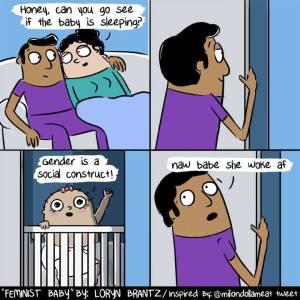Recently I was folding laundry in my bedroom while my kids got ready for their evening shower in our bathroom. I overheard my 4-year-old ask my 6-year-old “Why do boys have penises and girls have vaginas?”
“Well, remember,” my 6-year-old stated with authority, “not ALL boys have penises and not ALL girls have vaginas.”
Their conversation ended there, but affirmed our books and discussions about gender and gender identity were starting to gel, especially for our 6-year-old.
I was so moved by this brief but powerful interaction between my children, I shared their words on A Striving Parent’s Facebook page. Trolls quickly descended, with a barrage of transphobic and parent shaming comments. For better or for worse, I’ve grown accustomed to online harassment, so I made sure the security was tight on the site, deleted the comments and kept it moving.
But one theme from the messages stayed with me: the majority of commenters believed I was lying about my kids’ conversation. They were simply incredulous that such dialogue could happen between young children and were thus convinced I was lying for prosperity or for likes, I’m not exactly sure.
I was struck because sadly, it’s not just trolls who believe my children at 4 and 6 are too young to understand gender identity. I’ve had progressive educators tell me toddlers, preschoolers and kindergarteners do not have the capacity to grasp gender outside of the girl/boy binary due to their cognitive development.
Clearly, I call bullshit and so do many experts on gender and gender identity.
Please, read the linked article. There is a lot of helpful advice in the article for parents around how to frame discussions about gender and gender identity. As always, I’ve found using books to be a wonderful tool to ground talks with my kids. My four-year old currently loves I Am Jazz and Introducing Teddy. My 6-year-old is gravitating to It’s not the Stork, which is very heteronormative but useful in discussing anatomy in a straight forward manner. He also likes The Gender Wheel.

If you’re in Atlanta, head to Charis Books & More, where they have a wide variety of children’s books and books for adults about gender and gender identity. The staff will help you with your specific needs! For those of you not local to Atlanta, check out the Raising Luminaries blog and website for many wonderful book lists about gender and gender identity. As Wyatt says in Super Why!, when we have a question “we look in a book!”
I also make sure to interrupt any time I hear my kids reinforcing gender norms or the gender binary. If a television show or friend says some behavior or clothing is for a boy or for a girl, I push back immediately. Responses like “is there any toy that is just for a boy or just for a girl?” or “everyone gets to decide for themselves who they are and what they like,” tend to suffice.
When I read “It’s Not the Stork” to my 6-year-old, I remind him that while these body parts are ascribed to boys and girls, not all people identify with the sex they are assigned at birth. My primary goals are to help my kids see there are more ways to identify beyond the boy/girl gender binary and to help keep their expectations with regards to gender expression and identity remain as fluid as possible. We can build from this foundation as they mature.

Kids as young as toddlers can and should be taught about the many gloriously unique ways a person may identify. As Lindz Amer, a non-binary activist and educator who produces Queer Kid Stuff remarks in the above article:
“Young children are curious about the people and things they encounter, and LGBTQ+ people are part of the world…So let’s start telling kids that boy and girl aren’t the only two genders that exist, and that gender can be fluid — trust us, they can handle it.”
Trolls and progressive educators alike, please take note. With continuous threats and violent attacks on members of the LGBTQIA+ community and hateful and oppressive local and national politics, we can and must do better as parents. I refuse for any member of our society to be erased or ignored by my family, especially under the auspices that their identity or humanity is too difficult for my kids to understand. Children get it. It’s adults who need work.

Well, I have to say that your 6 year old child gets it.
LikeLike
Thank you for this article! I am a non-binary music teacher who just came out to the director of my school, and am introducing myself as Mx, with They/Them Pronouns when I start at the middle school this week. This article is a good reminder that the kids will be able to handle it. And hopefully the parents will too. 🙂
LikeLike
Serendipitously, we were reading It’s Not the Stork yesterday with my 4-year-old for the first time, and I noticed how normative and binary it is. Lots of conversations to be had there.
LikeLike
So normative! But we’ve found it easy to challenge. Thanks for commenting!
LikeLike